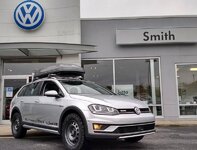Whitey
Member
Buy yourself a 4 door toyota tacoma, put a cap on the back, some decent tires, and about 3-400 lbs of sandbags in the back when it snows. And then never worry about getting anywhere, anytime, in any conditions ever again. Best ski trip vehicle ever.
I am on my 3rd Tacoma, each one went well over 200K miles with nothing much more than tires, brakes, and maintenance.
I am on my 3rd Tacoma, each one went well over 200K miles with nothing much more than tires, brakes, and maintenance.
